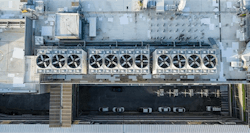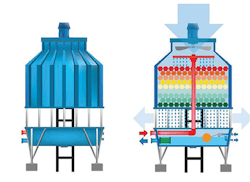By Rick Myer
The largest users of water in industrial and commercial applications, cooling towers can be used wherever a need for heat rejection exists. Power plants, high-rise buildings, hotels, hospitals, and schools are a few places that utilize cooling towers to support daily operations. Large and small, cooling towers can account for over 90 percent of the volume of wastewater sent to the sewer system.
With increased competition for domestic, industrial, and commercial uses, water efficiency is required across markets. We must boldly declare the deployment of new strategies to conserve water resources, in this case by addressing inefficiencies in cooling tower operation.
How can we improve upon our current model?
In order to understand how to improve upon the cooling tower process, one must understand how the existing process works. Cooling towers use evaporative cooling, a process in which water reduces the temperature of another object, evaporating as a result. Water is introduced to the system through the makeup flow, which showers cooling fins. These blades are designed to break up the water into smaller droplets, increasing its overall surface area, which provides more efficient cooling.The water used in this process cycles back through the system for reuse, a process called “cycling up.” Each cycle provides additional evaporation which concentrates the total dissolved solids (TDS), leading to an increased scaling potential within the tower. If scaling is not controlled, the cooling fins will become insulated, and the water will no longer provide its intended cooling effect. Once the dissolved solids reach a certain level, they are ejected from the cooling tower in a process called the blowdown. Cooling tower operators can mitigate scaling and increase the water cycle counts through the use of antiscalant chemicals and acids, but at an added cost.
Improvements can be made to the makeup and blowdown flows to conserve water and reduce chemical usage, leading to lower operational costs. MI Systems’ END® technology is designed for use in makeup and blowdown treatment. END® removes TDS by transporting the ions through ion exchange membranes without forcing the water to pass through such a barrier. This method of TDS removal allows the system to run at very low pressure and keeps scaling potential well below reverse osmosis.
Treatment of the makeup flow limits the use of necessary chemical treatment by removing the high scaling material before it enters the cooling tower. Cleaner makeup water allows the system to increase the number of times the water is cycled within the system, making the entire process more efficient and sustainable.
In blowdown treatment, END® can treat the water at very high recovery, back to the standards of the initial makeup water. This allows for an incredible reduction in wastewater sent to the sewer, again lowering operational costs significantly. An added benefit of the END® system is that it does not capture the scale inhibitors, corrosion inhibitors, and biocide chemicals used within the system, cycling them back into the makeup to be reused.
With recovery rates up to 98 percent and energy usage 50 percent below competitive technologies, END® is well-suited to turn cooling towers into more efficient users of the world’s most precious resource. IWW
About the Author: Rick Myer is business development officer at Magna Imperio Systems Corp. To learn more, visit www.magnaimperiosystems.com.



